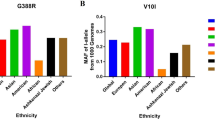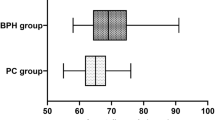Abstract
BACKGROUND:
CYR61 (cysteine-rich protein 61, also named IGFBP10) is a secreted signaling molecule that promotes angiogenesis and tumor growth. The goal of this study is to determine whether a functional polymorphism in the promoter region of the CYR61 gene (rs3753793) is associated with prostate cancer (PCa) risk and gene expression in Chinese patients.
METHODS:
A total of 665 patients diagnosed with PCa and 703 cancer-free controls were genotyped in this hospital-based case–control study, and 26 PCa tissue samples were evaluated for mRNA expression of CYR61 by real-time quantitative reverse-transcription PCR.
RESULTS:
Men carrying the G allele of rs3753793 (TG+GG) had significantly lower risk of PCa when compared with the TT genotype (odds ratio (OR)=0.76, 95% confidence interval (CI)=0.61–0.95). The association was generally more pronounced among subgroups of PCa patients with advanced stage (OR=0.70, 95% CI=0.53–0.94), Gleason score >7 (OR=0.63, 95% CI=0.46–0.86) and PSA>20 ng ml−1 (OR=0.68, 95% CI=0.53–0.88). Prostate tumors derived from cases with the GT/GG genotypes had significantly lower levels of CYR61 mRNA when compared with cases with the TT genotypes (P=0.02).
CONCLUSIONS:
Our results indicate that the genetic variation of rs3753793 in the CYR61 promoter may contribute to genetic predisposition to PCa and intra-tumor expression gene expression.
This is a preview of subscription content, access via your institution
Access options
Subscribe to this journal
Receive 4 print issues and online access
$259.00 per year
only $64.75 per issue
Buy this article
- Purchase on Springer Link
- Instant access to full article PDF
Prices may be subject to local taxes which are calculated during checkout


Similar content being viewed by others
References
Jemal A, Siegel R, Xu J, Ward E . Cancer statistics, 2010. CA Cancer J Clin 2010; 60: 277–300.
Bostwick DG, Burke HB, Djakiew D, Euling S, Ho SM, Landolph J et al. Human prostate cancer risk factors. Cancer 2004; 101 (10 Suppl): 2371–2490.
Quinn M, Babb P . Patterns and trends in prostate cancer incidence, survival, prevalence and mortality. Part I: international comparisons. BJU Int 2002; 90: 162–173.
Yang L, Parkin DM, Ferlay J, Li L, Chen Y . Estimates of cancer incidence in China for 2000 and projections for 2005. Cancer Epidemiol Biomarkers Prev 2005; 14: 243–250.
Bork P . The modular architecture of a new family of growth regulators related to connective tissue growth factor. FEBS Lett 1993; 327: 125–130.
Jay P, Berge-Lefranc JL, Marsollier C, Mejean C, Taviaux S, Berta P . The human growth factor-inducible immediate early gene, CYR61, maps to chromosome 1p. Oncogene 1997; 14: 1753–1757.
Perbal B . NOV (nephroblastoma overexpressed) and the CCN family of genes: structural and functional issues. Mol Pathol 2001; 54: 57–79.
Bleau AM, Planque N, Perbal B . CCN proteins and cancer: two to tango. Front Biosci 2005; 10: 998–1009.
Xie D, Nakachi K, Wang H, Elashoff R, Koeffler HP . Elevated levels of connective tissue growth factor, WISP-1, and CYR61 in primary breast cancers associated with more advanced features. Cancer Res 2001; 61: 8917–8923.
Xie D, Yin D, Tong X, O'Kelly J, Mori A, Miller C et al. Cyr61 is overexpressed in gliomas and involved in integrin-linked kinase-mediated Akt and beta-catenin-TCF/Lef signaling pathways. Cancer Res 2004; 64: 1987–1996.
Sun ZJ, Wang Y, Cai Z, Chen PP, Tong XJ, Xie D . Involvement of Cyr61 in growth, migration, and metastasis of prostate cancer cells. Br J Cancer 2008; 99: 1656–1667.
Bouchard L, Tchernof A, Deshaies Y, Lebel S, Hould FS, Marceau P et al. CYR61 polymorphisms are associated with plasma HDL-cholesterol levels in obese individuals. Clin Genet 2007; 72: 224–229.
Livak KJ, Schmittgen TD . Analysis of relative gene expression data using real-time quantitative PCR and the 2(-Delta Delta C(T)) Method. Methods 2001; 25: 402–408.
Franzen CA, Chen CC, Todorovic V, Juric V, Monzon RI, Lau LF . Matrix protein CCN1 is critical for prostate carcinoma cell proliferation and TRAIL-induced apoptosis. Mol Cancer Res 2009; 7: 1045–1055.
Babic AM, Kireeva ML, Kolesnikova TV, Lau LF . CYR61, a product of a growth factor-inducible immediate early gene, promotes angiogenesis and tumor growth. Proc Natl Acad Sci USA 1998; 95: 6355–6360.
Mo FE, Muntean AG, Chen CC, Stolz DB, Watkins SC, Lau LF . CYR61 (CCN1) is essential for placental development and vascular integrity. Mol Cell Biol 2002; 22: 8709–8720.
Mo FE, Lau LF . The matricellular protein CCN1 is essential for cardiac development. Circ Res 2006; 99: 961–969.
Kireeva ML, Lam SC, Lau LF . Adhesion of human umbilical vein endothelial cells to the immediate-early gene product Cyr61 is mediated through integrin alphavbeta3. J Biol Chem 1998; 273: 3090–3096.
Babic AM, Chen CC, Lau LF . Fisp12/mouse connective tissue growth factor mediates endothelial cell adhesion and migration through integrin alphavbeta3, promotes endothelial cell survival, and induces angiogenesis in vivo. Mol Cell Biol 1999; 19: 2958–2966.
Xie D, Miller CW, O'Kelly J, Nakachi K, Sakashita A, Said JW et al. Breast cancer. Cyr61 is overexpressed, estrogen-inducible, and associated with more advanced disease. J Biol Chem 2001; 276: 14187–14194.
Menendez JA, Mehmi I, Griggs DW, Lupu R . The angiogenic factor CYR61 in breast cancer: molecular pathology and therapeutic perspectives. Endocr Relat Cancer 2003; 10: 141–152.
Lin MT, Chang CC, Chen ST, Chang HL, Su JL, Chau YP et al. Cyr61 expression confers resistance to apoptosis in breast cancer MCF-7 cells by a mechanism of NF-kappaB-dependent XIAP up-regulation. J Biol Chem 2004; 279: 24015–24023.
Menendez JA, Vellon L, Mehmi I, Teng PK, Griggs DW, Lupu R . A novel CYR61-triggered 'CYR61-alphavbeta3 integrin loop' regulates breast cancer cell survival and chemosensitivity through activation of ERK1/ERK2 MAPK signaling pathway. Oncogene 2005; 24: 761–779.
Sakamoto S, Yokoyama M, Aoki M, Suzuki K, Kakehi Y, Saito Y . Induction and function of CYR61 (CCN1) in prostatic stromal and epithelial cells: CYR61 is required for prostatic cell proliferation. Prostate 2004; 61: 305–317.
Marra M, Abbruzzese A, Addeo R, Del Prete S, Tassone P, Tonini G et al. Cutting the limits of aminobisphosphonates: new strategies for the potentiation of their anti-tumour effects. Curr Cancer Drug Targets 2009; 9: 791–800.
Marra M, Santini D, Meo G, Vincenzi B, Zappavigna S, Baldi A et al. Cyr61 downmodulation potentiates the anticancer effects of zoledronic acid in androgen-independent prostate cancer cells. Int J Cancer 2009; 125: 2004–2013.
Han JS, Macarak E, Rosenbloom J, Chung KC, Chaqour B . Regulation of Cyr61/CCN1 gene expression through RhoA GTPase and p38MAPK signaling pathways. Eur J Biochem 2003; 270: 3408–3421.
D’Antonio KB, Schultz L, Albadine R, Mondul AM, Platz EA, Netto GJ et al. Decreased expression of Cyr61 is associated with prostate cancer recurrence after surgical treatment. Clin Cancer Res 2010; 16: 5908–5913.
Acknowledgements
This work was supported by the Program for Development of Innovative Research Team in the First Affiliated Hospital of Nanjing Medical University, Provincial Initiative Program for Excellency Disciplines of Jiangsu Province, by the National Natural Science Foundation of China (grant number 81171963 and 81102089) and the Natural Science Foundation of Jiangsu Province (grant number BK2008473 and BK2011773).
Author information
Authors and Affiliations
Corresponding authors
Ethics declarations
Competing interests
The authors declare no conflict of interest.
Rights and permissions
About this article
Cite this article
Tao, L., Chen, J., Zhou, H. et al. A functional polymorphism in the CYR61 (IGFBP10) gene is associated with prostate cancer risk. Prostate Cancer Prostatic Dis 16, 95–100 (2013). https://doi.org/10.1038/pcan.2012.41
Received:
Revised:
Accepted:
Published:
Issue Date:
DOI: https://doi.org/10.1038/pcan.2012.41
Keywords
This article is cited by
-
Association between CCN1 gene polymorphism and acute coronary syndrome in Chinese Han and Uygur populations
Hereditas (2021)
-
CCN1 gene polymorphisms associated with congenital heart disease susceptibility in Northwest Chinese population from different high-altitude areas
Environmental Science and Pollution Research (2021)



